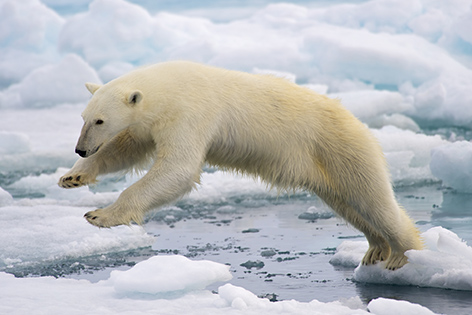
奔跑吧,北极熊!
Polar Bears Must Work Harder on Faster Sea Ice Treadmill
奔跑吧,北极熊!
Thinner sea ice is getting pushed farther by Arctic winds, which makes polar bears walk more to stay in the same place, increasing their need for food.
北冰洋的浮冰变得更薄,使它们在寒风的驱使下更快的移动,也使北极熊需要走动更多的距离以保留在同一地点,这增加了这些熊类的食物需求。
撰文 茱莉亚·罗森(Julia Rosen)
翻译 Meatle
审校 邰伦玥
Polar bears live on floating rafts of sea ice, hunting for seals. But in the Arctic Ocean north of Alaska, the cold polar wind constantly blows that ice from east to west. Which means that the polar bears there are on a kind of treadmill.
北极熊,它们栖息在浮冰之上,靠猎食海豹维生。在阿拉斯加以北,北冰洋之上,冰冷而不绝的极地海风推动着浮冰自东往西行进。对于北极熊而言,这就像跑步机一样。
"If the bears don't compensate that drift, they would all drift to Russia. So over the course of a year they need to walk back against that prevailing drift to remain in the Alaska territories." David Douglas, a biologist with the U.S. Geological Survey in Juneau, Alaska.
“如果北极熊不走动以抵消漂流带来的位移,它们将随浮冰漂到俄罗斯附近。因此全年之中,它们需要不停的移动,以抵消永不停息的浮冰漂移,确保自己始终在阿拉斯加区域内。”美国地质调查局亚拉斯加分部,朱诺地区的生物学家,大卫·达格拉斯如是道。
Recently, researchers realized that the ice drift in this part of the Arctic Ocean has accelerated from about three kilometers per day up to five. That's probably because climate change has made the sea ice thinner and easier for the winds to push. And that means the polar bear treadmill has sped up too.
最近,研究人员发现该地区的冰川漂移速度从原来的3km/h提升到了5km/h。那可能是因为气候变化使浮冰变得更薄,更易受到海风的驱动。同时,这种加速令到北极熊的“跑步机”变得更快。
Douglas and his colleagues tracked Alaskan polar bears fitted with radio collars. They found that the animals are working harder than ever to compensate for the faster drift. And just like when we exercise, bears have to eat more food to make up for the extra calories they're burning—between one and four more seals per year, depending on whether the bears are single or raising cubs.
道格拉斯和他的同僚通过无线颈环追踪着阿拉斯加地区的北极熊。他们发现,相比过去,这些熊需要更为努力地去抵消漂流作用。而正如我们做运动一样,这些北极熊需要更多的食物去补充更多的走动所带来的体力消耗。它们需要比以往寻觅多一到四顿的海豹,这取决于它是孤身一熊还是在抚养幼崽。
"While that may not seem like a lot of seals or a big demand, it also comes at a time when the habitat that they have to hunt in is shrinking. So they have less area on which to hunt seals, at the same time needing to hunt more."
“或许那看起来并不是很多海豹,也不是很大的需求,但这个现象刚好与它们的觅食地正在萎缩的情况同时发生。因此这些北极熊狩猎的地区变小了,却有了更多的食物需求。”
Douglas, after presenting the research December 15th at the fall meeting of the American Geophysical Union in San Francisco. [David Douglas et al, Increased Arctic Sea Ice Drift Alters Polar Bear Movements and Energetics]
这些对话录制于12月15日,在三藩市举行的美国地球物理学会秋季会议上。
He's particularly worried that the changes in sea ice may hurt young bears' chances of survival, especially in the southern Beaufort Sea, north of Prudhoe Bay. Researchers have studied these bears for more than 30 years, and have watched their numbers decline.
道格拉斯忧心于这种浮冰的变化会削减年幼的北极熊的生存率,尤其是在波弗特海以南、普拉德霍湾以北的地区的北极熊。研究人员对这些北极熊进行了长达三十年的研究,见证了它们数量的减少。
"We didn't see this coming three decades ago when we started tracking bears. We thought we were simply getting baseline data on a population, and never foresaw that the Arctic would undergo such dramatic change." That, like the sea ice, may be accelerating.
“在三十年前,当我们刚开始追踪北极熊的时候,我们没想到这样的事情会发生。我们以为我们在简单地收集种群数量的标准数据,而并没有预见到北极圈会发生如此大的变化。”而这种变化,就像浮冰一样,也在不停地加速。
未经书面许可任何人不得复制或镜像
京ICP备11000850号-1
 京公网安备11010502039775号
京公网安备11010502039775号 信息网络传播视听节目许可证0111611号
国家科技基础条件平台

















